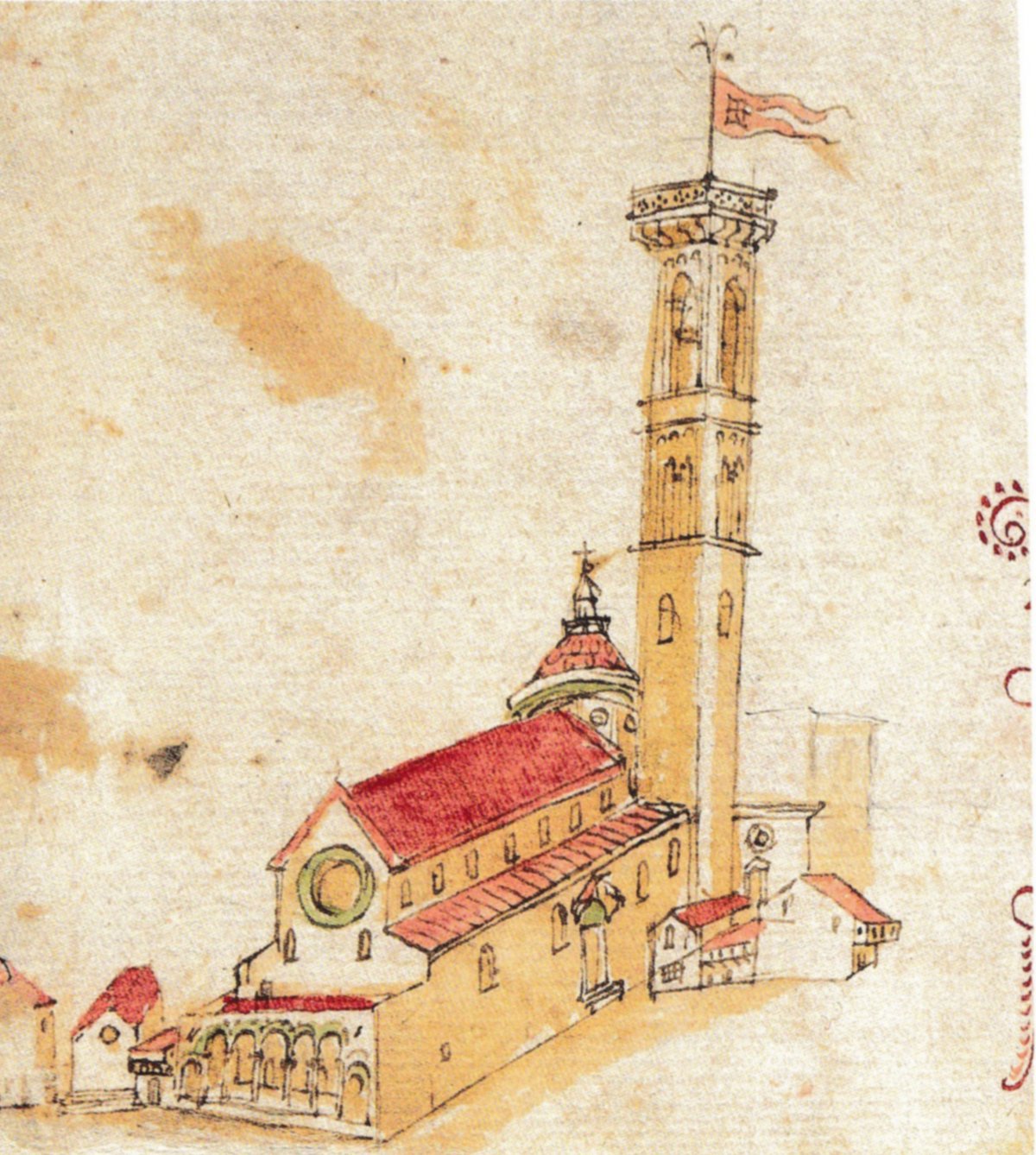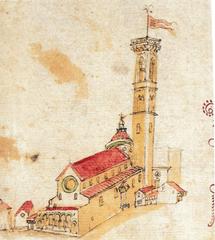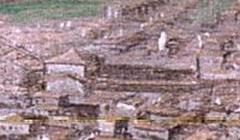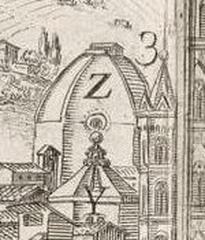
Basilica of San Lorenzo Florence: Visiting Hours, Tickets, and Historical Sites Guide
Date: 14/06/2025
Introduction: History and Cultural Significance
Located in the vibrant heart of Florence, Italy, the Basilica of San Lorenzo is an enduring symbol of the city’s Renaissance legacy and the Medici family’s profound influence. As one of Florence’s oldest churches—originally consecrated in 393 CE—the basilica began as a modest structure outside the city walls. Over the centuries, it evolved into a grand Renaissance complex, thanks to the patronage of the Medici and the architectural vision of Filippo Brunelleschi. The basilica’s interior, highlighted by Donatello’s sculptural masterpieces and Michelangelo’s innovative designs, showcases the transition from medieval to Renaissance ideals—symmetry, harmony, and proportion. Today, the San Lorenzo complex includes the Old Sacristy, New Sacristy, Laurentian Library, and the Medici Chapels, making it an essential destination for art lovers, history enthusiasts, and travelers eager to explore Florence’s rich heritage. For planning details and the latest updates, consult the Florence tourism website and the Basilica of San Lorenzo official site.
Contents
- Introduction and Historical Overview
- Early Origins and Founding
- Medici Patronage and Renaissance Transformation
- Artistic and Architectural Highlights
- Visiting Information
- Visiting Hours
- Ticket Information and How to Buy
- Accessibility and Travel Tips
- Guided Tours and Special Events
- Architectural Masterpieces
- Brunelleschi’s Vision
- The Unfinished Façade
- Donatello’s Sculptural Treasures
- Medici Tombs and Patronage
- Paintings and Decorative Art
- Cloisters and San Lorenzo’s Treasure
- Nearby Attractions and Itinerary Suggestions
- Visitor Tips
- Frequently Asked Questions (FAQs)
- Visuals and Media
- Internal and External Links
- Conclusion and Call to Action
Historical Overview
Early Origins and Founding
The Basilica of San Lorenzo was consecrated in 393 CE by Saint Ambrose of Milan and initially stood outside Florence’s city walls, reflecting the city’s modest size during late antiquity (visitflorence.com). For almost three centuries, it was Florence’s cathedral before Santa Reparata took over the role (art-facts.com).
Medici Patronage and Renaissance Transformation
The Medici family’s ascent brought a new era for San Lorenzo. In 1419, Giovanni di Bicci de’ Medici commissioned Filippo Brunelleschi to rebuild the church, introducing classical Roman elements that defined the emerging Renaissance style (art-facts.com). Brunelleschi completed the Old Sacristy; the rest of the basilica was finished by his followers. Michelangelo designed an ambitious marble façade, but it remains unfinished, symbolizing the contrast between the church’s simple exterior and its richly adorned interior (visitflorence.com).
Artistic and Architectural Highlights
The San Lorenzo complex features the Old Sacristy (decorated by Donatello), the New Sacristy (with Michelangelo’s iconic sculptures), the Laurentian Library, and the Medici Chapels (visitflorencemuseums.com). These spaces exemplify the Medici’s patronage and Florence’s cultural achievements during the Renaissance.
Visiting Information
Visiting Hours
- Basilica and Crypt:
- Monday to Saturday: 10:00 AM – 5:30 PM
- Closed to tourists on Sundays (occasionally open Sunday afternoons in summer)
- May close for religious services or special events (European Traveler; WhichMuseum)
- Laurentian Library:
- Weekdays: 9:30 AM – 1:30 PM
- Closed weekends and public holidays (The Geographical Cure)
- Medici Chapels:
- Separate entrance and hours; check official site for updates.
Ticket Information and How to Buy
- Basilica and Crypt:
- Standard admission: €9
- Children under 12: Free
- Combination ticket (with Laurentian Library): €9.50
- Tickets available at the cloisters entrance (left of the unfinished façade) (European Traveler)
- Laurentian Library:
- Separate ticket: €4
- Medici Chapels:
- Separate ticket; skip-the-line options available online (The Geographical Cure)
Tips:
- The Firenze Card covers all San Lorenzo sites and allows direct access.
- Visit the basilica before the crypt; reverse order is not permitted.
- Purchase Medici Chapels tickets online during peak periods.
Accessibility and Travel Tips
- The basilica and main nave are wheelchair accessible. Some chapels and the Laurentian Library have steps or uneven surfaces.
- Audio guides and multimedia apps are available for detailed commentary (Weekend in Italy Multimedia Guide).
- Dress modestly (shoulders and knees covered).
- Non-flash photography is generally allowed (restrictions may apply).
Guided Tours and Special Events
- Guided tours in multiple languages focus on art, history, and Medici patronage. Booking in advance is recommended.
- Special events and religious ceremonies are held throughout the year; check official sources for schedules.
Architectural Masterpieces
Brunelleschi’s Vision
Brunelleschi’s design revolutionized church architecture with a Latin cross plan, harmonious proportions, and the use of gray pietra serena columns. The flat coffered ceiling and clear-glass windows bathe the nave in natural light, highlighting the sense of order and tranquility.
The Unfinished Façade
The church’s rough stone façade, left incomplete after Michelangelo’s plans were abandoned, stands in stark contrast to its refined interior. This unique feature adds to the basilica’s character.
Donatello’s Sculptural Treasures
The Pulpits
Donatello’s bronze pulpits, his final masterpieces, depict scenes from the Passion and Resurrection with dynamic, expressive figures.
The Old Sacristy
A harmonious cubic chapel crowned with a dome, the Old Sacristy features Donatello’s polychrome stucco work and bronze doors. The dome’s celestial blue and gold night sky marks the Medici’s spiritual and artistic ambitions.
Medici Patronage and Tombs
The basilica served as the Medici family’s parish church. Many are buried in the Old Sacristy and the Medici Chapels, which house monumental tombs and Michelangelo’s celebrated sculptures.
Paintings and Decorative Art
Notable works include Bronzino’s “The Martyrdom of St. Lawrence” and subtle Medici heraldic decorations, which punctuate the basilica’s restrained ornamentation.
Cloisters and San Lorenzo’s Treasure
The Main Cloister
A green, peaceful space with a two-story loggia, the cloister offers a tranquil entry point and is lined with memorials.
The Crypt and Treasure Museum
The crypt beneath the basilica houses a collection of altar decorations, liturgical vessels, and reliquaries collected over centuries.
Nearby Attractions and Recommended Itinerary
- Mercato Centrale: Florence’s central food market.
- Palazzo Medici-Riccardi: Home to the famous Magi Chapel.
- Florence Cathedral (Duomo): Iconic landmark minutes away.
- Laurentian Library: Renaissance library designed by Michelangelo.
Combine your visit to San Lorenzo with these sites for a complete Florentine experience.
Visitor Tips
- Arrive early or late in the day to avoid crowds.
- Use the multimedia guide via QR code for in-depth commentary.
- Comfortable shoes are recommended.
- Large bags are not permitted; security checks are in place.
- The market area around San Lorenzo is lively—secure your valuables.
Frequently Asked Questions (FAQs)
Q: What are the Basilica of San Lorenzo opening hours?
A: Monday to Saturday, 10:00 AM – 5:30 PM; closed to tourists on Sundays except some summer afternoons.
Q: How do I buy tickets?
A: Tickets are sold at the cloisters entrance and online for the Medici Chapels. The Firenze Card is also valid.
Q: Is the basilica accessible for wheelchair users?
A: Yes, the main entrance and nave are wheelchair accessible. Some chapels may have steps.
Q: Are guided tours available?
A: Yes, in multiple languages; advanced booking recommended.
Q: Can I take photos inside?
A: Non-flash photography is generally allowed in the basilica, but not in all areas.
Visuals and Media
- Image suggestions:
- “Basilica of San Lorenzo Florence exterior”
- “Old Sacristy interior San Lorenzo”
- “Michelangelo’s staircase Laurentian Library”
- “Brunelleschi’s coffered ceiling and columns in San Lorenzo”
- “Donatello’s bronze pulpits inside Basilica of San Lorenzo”
Internal and External Links
Conclusion and Call to Action
A visit to the Basilica of San Lorenzo is an immersive journey into Florence’s Renaissance soul. From Brunelleschi’s architectural innovations to Donatello’s and Michelangelo’s masterpieces, every corner of the complex reveals a chapter of Medici and Florentine history. Plan ahead by checking official hours, purchasing tickets online, and exploring the basilica with an audio guide for a richer experience. Enhance your visit using the Audiala app and follow us for the latest tips and updates on Florence’s treasures.
Summary and Final Tips
The Basilica of San Lorenzo blends architectural brilliance, artistic mastery, and the Medici legacy, making it a cornerstone of any Florence itinerary. With well-organized visitor services, accessible facilities, and a central location, it’s easy to add San Lorenzo to your travel plans. For a rewarding visit, purchase tickets in advance, arrive early, and use available guides for deeper insight. Stay informed about special events through official channels and apps like Audiala.
For comprehensive information and real-time updates, visit the official Basilica website, European Traveler, and Visit Florence.
Sources and Further Reading
- Basilica of San Lorenzo Visiting Hours and Tickets: A Guide to Florence’s Historic Landmark, VisitFlorence
- Basilica of San Lorenzo Facts, Art-Facts
- Medici Chapels, Visit Florence Museums
- Basilica of San Lorenzo Visitor Guide, FlorenceWise
- San Lorenzo and the Medici Chapel in Florence, The Geographical Cure
- Basilica of San Lorenzo Visiting Hours and Ticket Information, European Traveler
- Basilica of San Lorenzo Visiting Hours, Tickets & Art Highlights in Florence, Weekend in Italy Multimedia Guide
- Official Basilica of San Lorenzo website
- Florence tourism website









































































